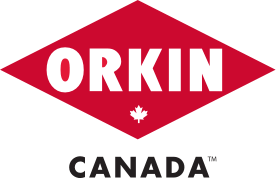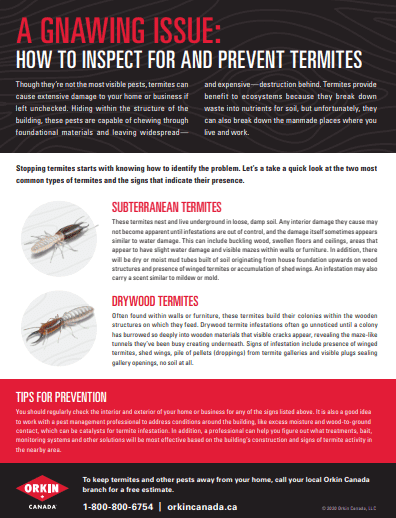Though they’re not the most visible pests, termites can cause extensive damage to your home or business if left unchecked. Hiding within the structure of the building, these pests are capable of chewing through foundational materials and leaving widespread—and expensive—destruction behind.
Termites provide benefit to ecosystems because they break down waste into nutrients for soil, but unfortunately, they can also break down the man made places where you live and work. Stopping termites starts with knowing how to identify the problem. Let’s a take a quick look at the two most common types of termites and the signs that indicate their presence.
Subterranean Termites
These termites nest and live underground in loose, damp soil. Any interior damage they cause may not become apparent until infestations are out of control, and the damage itself sometimes appears similar to water damage. This can include buckling wood, swollen floors and ceilings, areas that appear to have slight water damage and visible mazes within walls or furniture.
In addition, there will be dry or moist mud tubes built of soil originating from house foundation upwards on wood structures and presence of winged termites or accumulation of shed wings. An infestation may also carry a scent similar to mildew or mold.
Are You Seeing Signs of Termites? Contact us Today!
Drywood Termites
Often found within walls or furniture, these termites build their colonies within the wooden structures on which they feed. Drywood termite infestations often go unnoticed until a colony has burrowed so deeply into wooden materials that visible cracks appear, revealing the maze-like tunnels they’ve been busy creating underneath.
Signs of infestation include presence of winged termites, shed wings, pile of pellets (droppings) from termite galleries and visible plugs sealing gallery openings, no soil at all.
Tips For Prevention
You should regularly check the interior and exterior of your home or business for any of the signs listed above. It is also a good idea to work with a pest management professional to address conditions around the building, like excess moisture and wood-to-ground contact, which can be catalysts for termite infestation.
Need more termite tips? Click Here
In addition, a professional can help you figure out what treatments, bait, monitoring systems and other solutions will be most effective based on the building’s construction and signs of termite activity in the nearby area.
For additional details on taking care of termite problems, check out Orkin Canada’s free guide here.

You may also like
Top Pests Expected To Trend In The Summer Of 2023
Warm weather is around the corner, which means pests that have been overwintering or hibernating will wake up as well as non-hibernating pests will start making an appearance outdoors. Being prepared for those spring and summer pests can have an impact on how enjoyable your time will be at home or at work. Using industry leading expertise, we have put together a comprehensive list on the top 8 pests expected to trend in the summer of 2023. This list will provide a deeper dive into the impact that pests can have on your property, along with prevention tips to keep your home or business pest-free.
6 Termite Tips From Your Orkin Canada Technician
If you haven't done a home inspection recently, you could have a ticking time bomb underneath your feet, termites. You don't have to know which wire to cut in order to diffuse an explosive situation. Here are a few simple tips to conduct a home inspection that will help keep any potential termites at bay.
7 Signs Of Termite Evidence You Need To Know
Termites are the bane of any home or business. As termites are responsible for millions of dollars in damage to homes across Canada. This is why recognizing evidence of a termite infestation early on can ensure that your property is treated before the structure is compromised. Here are seven signs of termite evidence you need to be aware of.
Time for Your Business to Terminate Termites
Are termites eating away at your business? Not only do these pests show up to work unannounced, but they toil away at your building’s structure - often undetected until it is too late.
Remove pests from your home, and stop them from coming back
We work hard to listen, understand and assess your unique situation. Request a free, no-obligation estimate today for a customized pest program that fits your needs.
Request a Free Home EstimateRequest a Free Business Consultation


